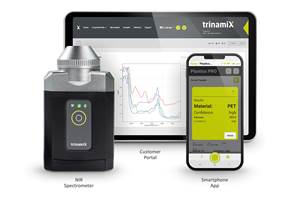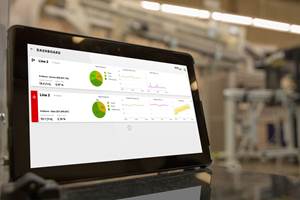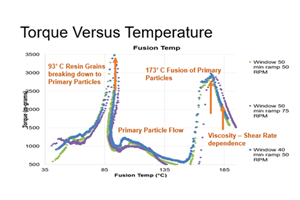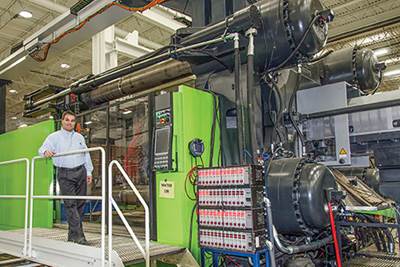Portable 3D Laser Scanner Slashes Molder’s Inspection Time
EVCO reduced first-article inspection time from one week to as little as 4-6 hours.
Use of portable 3D laser-scanning equipment has helped EVCO Plastics, DeForest, Wis., visualize its “point cloud” of x-y-z scan data on a prototype or production part faster and more clearly and thereby streamline its quality inspection.
With portable laser scanning, the comparison of the molded part’s point cloud to the CAD file can achieve faster first-article inspection. The 53-year-old custom injection molder employs over 1200 at its nine locations in the U.S., Mexico, and China. It operates more than 170 presses in the 28- to 3500-ton range. The firm does its own mold building and has a world-class metrology lab for quality evaluation.
Part of EVCO’s production strategy is the ability to take a part, scan it, and compare it to the original CAD file as early as possible in the process. This allows customers to observe how the plastic product compares with the solid model, according to Rich Duval, director of quality. He also notes that by using laser scanning and reverse engineering, EVCO has been able to recreate the surface of tooling where solid models don’t exist and provide this data to a tool shop for steel revisions.
Within the last two years, a combination of the growing work volume and the challenges of uniquely designed injection molded products drove the need to collect data with an alternative to CMMs. EVCO sought assistance from supplier partner Exact Metrology Inc., Brookfield, Wis. Exact both sells metrology equipment and performs very complex scanning services for customers.
Having researched earlier generation scanning equipment, EVCO saw that Exact’s product offering included more advanced Romer and other brands of laser-scanning arms. EVCO purchased one Romer arm to measure large parts, prototypes, and tooling. Examples include outboard-motor covers for boats, agricultural vehicle interior parts, and large appliance parts. EVCO has also used it on smaller parts such as medical-device components. “We can scan a part on all sides and get dimensions and then compare it to the CAD model. Depending on the application, inspection time can be reduced from one week to 4-6 hr.”
The Romer arm measures the object just as accurately as most conventional CMMs, and much faster, Duval says. Further, it’s portable and can be used with large structures or objects—the primary reason it was developed. Duval notes that his team of technicians has been able to “marry” the Romer arm and conventional CMM technology. The combination of the 3D scans with the bridge CMM plates gives technicians and design engineers the necessary comparative data to resolve any issue that arises.
EVCO has used the Romer arm to take a damaged tool component and reconstruct the cogs on a machine gear that formed part of an assembly. The damaged gear was scanned, then reverse engineered for replacement—absent original parts. Also, older molds are being evaluated with the scanning techniques for positions of runners, pins, cores, and other components. Often, reverse engineering from existing parts is also performed in the lab for resolving production issues or validating parts.
Duval waited to acquire the technology once the software and the computer speed were optimized. He says the cost of this technology has dropped by at least 50% in the last 10 years. EVCO is considering the acquisition of additional Romer arms and is exploring industrial CT scanners, which have dropped in cost by at least $150,000 from the original $450,000 price.
Related Content
Handheld NIR Instrument Distinguishes PET from PETG
Mobile spectroscopy from trinamiX detects more than 30 different plastics—and now PET vs. PETG as an aid to recycling.
Read MoreHow to Improve Quality with Offline Inspection and Analysis
Automated sample testing with a light table detects the smallest contamination in flakes, micro granulates and sample test sheets.
Read MoreHow Inline Vision Inspection Can Minimize Scrap in Molding
Once viewed by injection and blow molders as a necessary evil, machine vision technology today can continuously monitor and improve production while reducing costs.
Read MoreTry This Alternate Method for Heating Your Torque Rheometer
Rheometers are generally not on all the time. And most users have found that the first test run in the instrument after heating up is not very reliable and is usually discarded. Try this method instead.
Read MoreRead Next
EVCO Plastics at 50: Still Thinking Big
In its first half-century, EVCO Plastics has grown from one half-ounce injection machine in a basement to a $130 million company with 148 presses and 900 employees at nine plants in the U.S., Mexico, and China.
Read MoreRecycling Partners Collaborate to Eliminate Production Scrap Waste at NPE2024
A collaboration between show organizer PLASTICS, recycler CPR and size reduction experts WEIMA and Conair will seek to recover and recycle 100% of the parts produced at the show.
Read MoreFor PLASTICS' CEO Seaholm, NPE to Shine Light on Sustainability Successes
With advocacy, communication and sustainability as three main pillars, Seaholm leads a trade association to NPE that ‘is more active today than we have ever been.’
Read More

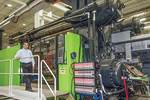








 (2).jpg;maxWidth=300;quality=90)








